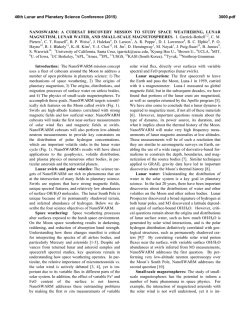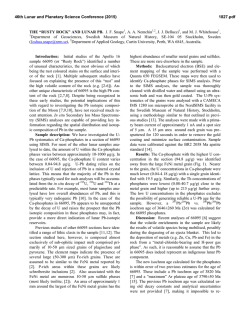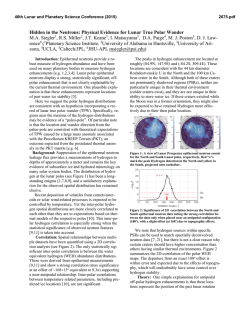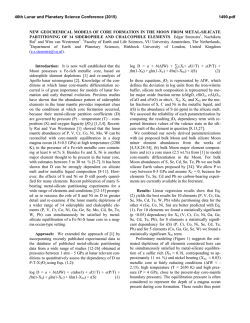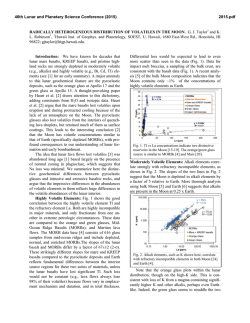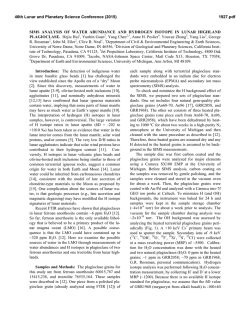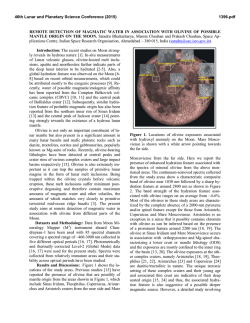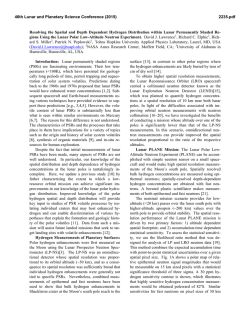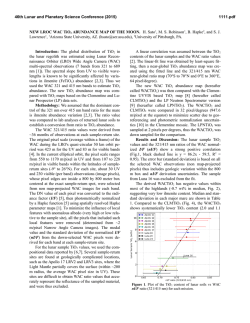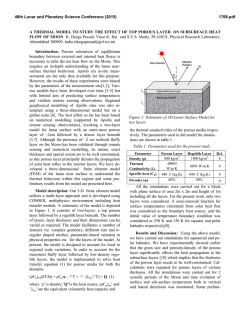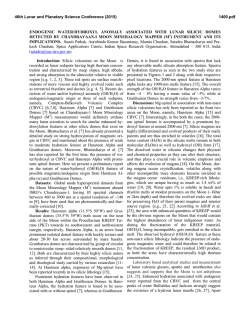
THE MATURELY, IMMATURE ORIENTALE IMPACT BASIN. J. T. S.
46th Lunar and Planetary Science Conference (2015) 2981.pdf THE MATURELY, IMMATURE ORIENTALE IMPACT BASIN. J. T. S. Cahill, D. J. Lawrence, O. Delen, A. Stickle, and R.K. Raney, 1The Johns Hopkins University Applied Physics Laboratory, Laurel, MD, ([email protected]). Introduction: The Moon is consistently bombardregolith that is consistent with a relative old age date ed by large and small projectiles that weather its surdetermination (at least ~3.5 Ga; Fig. 2). Here, in an face. This includes micrometeorites, cosmic and solar effort to better understand how the lunar regolith is rays, and solar wind implantation and sputtering in a weathered not only on the surface, but within the upper process known as space weathering. Based on data ~1 m of regolith, we more fully characterize the Orienfrom the Clementine spacecraft, several studies [2, 4, tale region relative to other H-depleted regions. We do 5] have shown that the degree of this process imparted this by examining the similarities and differences beupon the lunar surface can be estimated in the neartween neutron, radar, near-, and thermal- infrared obinfrared with the optical maturity parameter (OMAT; servations. Fig. 1a). However, near-infrared spectroscopy only Data Products: Each of the data products measures a unique quality about the regolith. Theregives us a perspective of how space weathering affects fore, areas where they differ offer just as much or more the upper microns of the lunar surface. As informative information about the regolith as areas where they as the OMAT parameter has proven to be, it does not agree. LP neutron counts are sensitive to the presence inform us to the degree space weathering imparted of hydrogen on the lunar surface in a variety of forms. upon shallow subsurface materials (<1.5 m). However, here we are interested in the non-polar highRecently, studies of data sets from Lunar Prospeclands from which is most likely solar wind implanted tor (LP) and Lunar Reconnaissance Orbiter (LRO) that hydrogen. LP neutron counts and H-maps used here are sensitive to a greater depth of the lunar regolith are are the same reported in Lawrence et al. [1]. Also exbeginning to report measures of space weathering. amined are Mini-RF circular polarization ratio (CPR) These include the thermal infrared, radar, and neutron maps of Cahill et al. [8]. Mini-RF is a synthetic aperspectroscopy data sets [1, 6, 7]. Some aspects of each ture radar (SAR) onboard LRO that collected global Sof these data sets are directly comparable to OMAT band (12.6 cm) maps which are sensitive to 1-2 meters estimates. For example, a study by Lawrence et al. [1] vertically. A relevant product derived from Stokes pashows evidence that LP-measured epithermal neutron rameters for this study is CPR defined as the same counts in the lunar highlands (defined here as areas sense relative to the opposite sense polarized return, with <3.5 ppm thorium) correlate relatively well with SC/OC. Values of CPR serve as quantitative estimates 750 nm albedo, OMAT, and the Diviner Christensen of surface roughness and composition. LRO’s Diviner Feature (CF). From these data, Lawrence et al. [1] was rock abundance (RA) and CF maps were derived by [9, able to determine and map hydrogen abundances in the 10], and OMAT maps are derived with the methodololunar highlands (Fig. 1b). Because these abundances gy of Lucey et al. [4]. are correlated with previous determinations of space weathering (for non-polar contexts) Lawrence et al. [1] has interpreted these abundances to be driven and maintained by Himplantation into the upper ~10 cm of the lunar regolith by solar wind. In this context, areas of high H abundances are interpreted to be more mature, while areas of depleted H abundances are interpreted to be immature (e.g., Tycho). One of the peculiarities of Lawrence et al. [1]’s lunar H-maps are the regions depleted in hydrogen. While Tycho is shown to consist of H-depleted material, consistent with OMAT maps showing it to be immature, other H-depleted regions conflict with previous interpretations discerned by OMAT maps. Orientale basin is the most prominent example, shown to be HFigure 1: Global lunar (top) Clementine-derived OMAT and (bottom) depleted despite a relatively mature upper Lunar Prospector-derived Hydrogen abundance map [1-3]; 2 ppd. 46th Lunar and Planetary Science Conference (2015) 2981.pdf (b) (c) Figure 2: Orientale impact basin in (a) LROC WAC monochrome, (b) Lunar Prospector derived Hydrogen, and (c) Mini-RF derived CPR maps at 2 ppd. Discussion: OMAT maps of Orientale show it to be mature albeit not the most mature region on the Moon; this is generally consistent with Orientale’s interpreted age (~3.7 Ga) although still considered one of the youngest basins. Radar is used as a proxy for maturity as Neish et al. [7] demonstrated by directly comparing CPR and OMAT of crater ejecta. However, in the context of Orientale, OMAT and radar backscatter characteristics disagree. Cahill et al. [8] noted the prominence of Orientale in S-band CPR and m-chi data products and suggested the reason for these characteristics may be buried subsurface material with immature characteristics not exhibited at the surface. Orientale shows little to no RA concentrations on the surface while also exhibiting higher m-chi double bounce and volume scattering characteristics than its surroundings and the bulk of the lunar surface. At first glance, H-maps and CPR maps agree in terms of Orientale being highly immature. H-maps suggest depleted average hydrogen abundances (<35 ppm) for Orientale highlands material. Although the spatial distribution of high CPR and H-depleted terrain is similar, high CPR material extends further from the center of Orientale. LP neutron and Mini-RF overlap somewhat in regolith sampling cross section sampling the upper ~10 cm (LP) to 10 cm to 1.5 m (Mini-RF). Summary and Ongoing Work: Our view of lunar highlands measures of regolith maturity has been expanded with LP and LRO Mini-RF and Diviner instrument observations. This is supported globally in many locations with large-scale regions showing hydrogen, RA, CF, CPR, and m-chi measures relatively consistent with near-infrared measures (i.e., OMAT) of maturity. However, there are differences and the variations in the spatial distribution and intensity of these measures imply that there is additional information about lunar space weathering contributions recorded within the same regolith that are yet to be fully discerned, disentangled, and understood. In the context of Orientale, these differences may imply depth of sampling effects specific to the measurement technique and/or physical (e.g., regolith versus impact melt) and compositional (e.g., anorthositic versus pure anorthosite materials) characteristics specific to Orientale materials. Ultimately, these results are peculiar given the age (~3.7 Ga) of Orientale and yet to be fully resolved. References: [1] Lawrence D.J. et al. (2015) Icarus, in review. [2] Lucey P.G. et al. (1998) JGR, 103, 3679-3699. [3] Le Mouélic S. et al. (2002) JGR, 107, 5074. [4] Lucey P.G. et al. (2000) JGR, 105, 20377-20386. [5] Le Mouélic S. et al. (2000) JGR, 105, 9445-9455. [6] Lucey P.G. et al. (2013) LPSC, XXXXIV, 2890. [7] Neish C.D. et al. (2014) Icarus, 239, 105-117. [8] Cahill J.T.S. et al. (2014) Icarus, accepted, doi: 10.1016/j.icarus.2014.07.018. [9] Bandfield J.L. et al. (2011) JGR, 116, doi:10.1029/2011JE003866. [10] Greenhagen B.T. et al. (2010) Science, 329, 1507-1509.
© Copyright 2026


